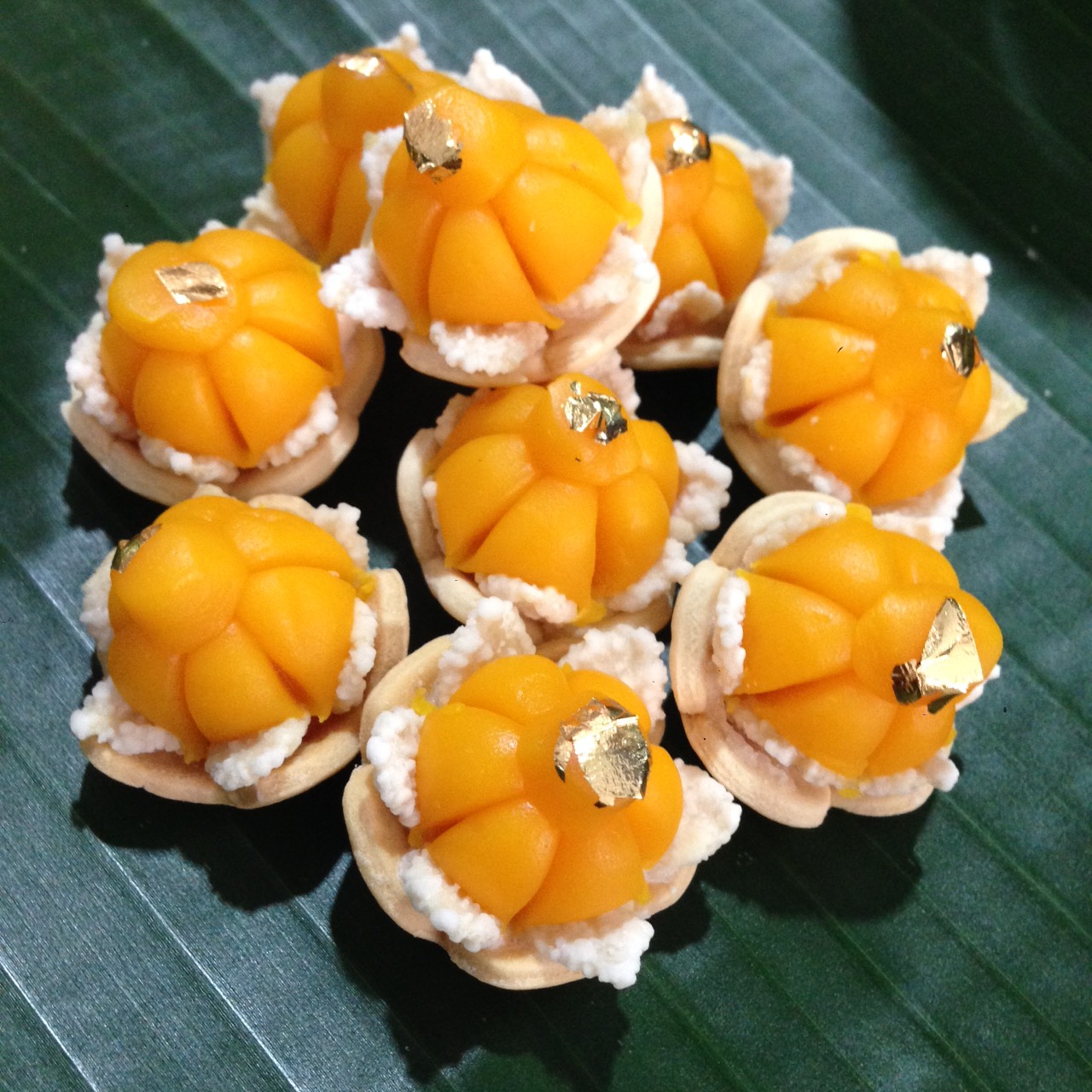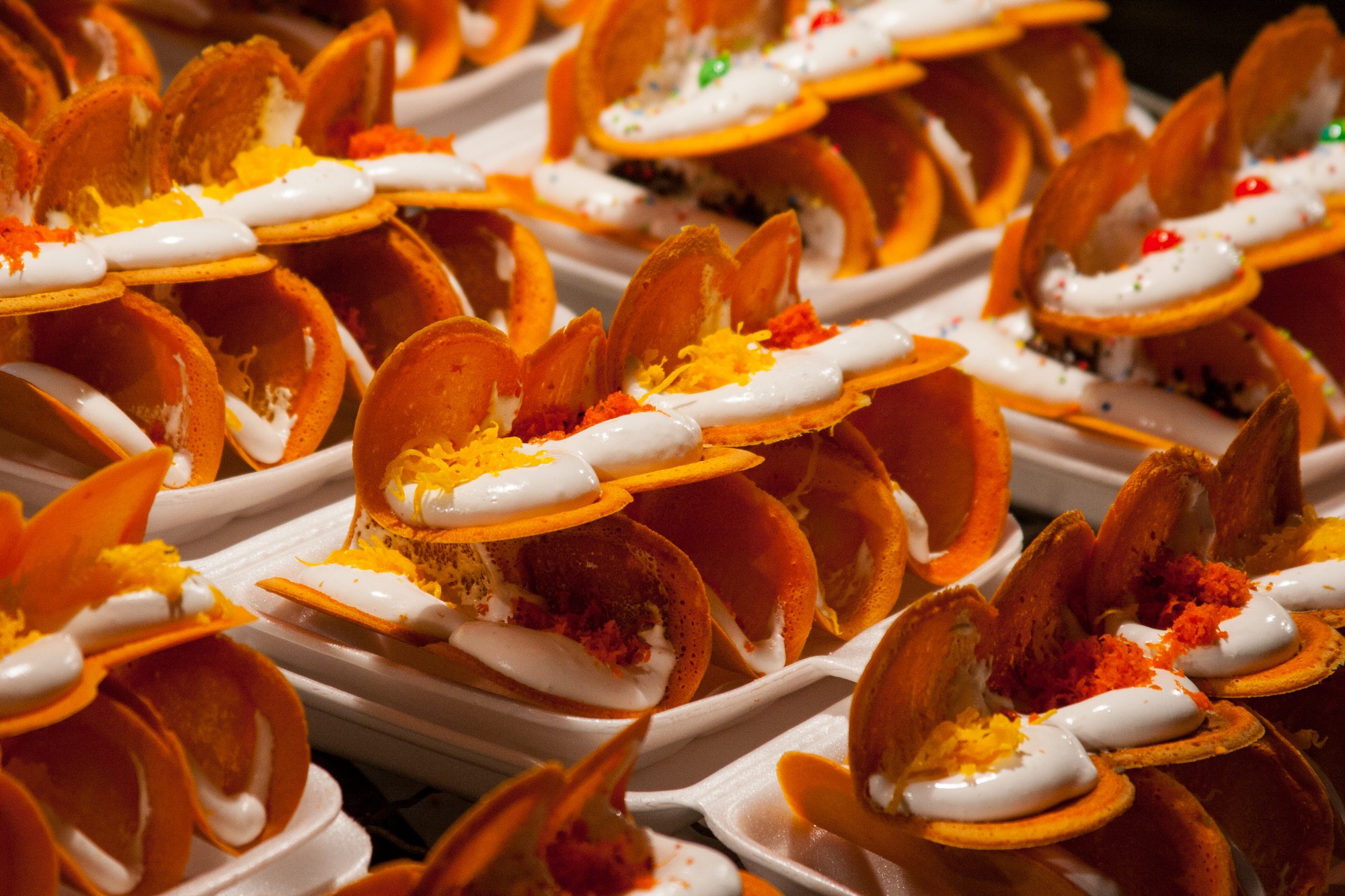|
Khao Mak
''Khao mak'' ( th, ข้าวหมาก, ), also known as "Thai fermented sweet rice dessert", is a Thai dessert. The sticky rice used to prepare ''khao mak'' is fermentation, fermented for several days, resulting in an alcohol content of just over one percent. It has a noticeable alcohol flavor with a sweet taste and is often packaged in banana leaves. ''Look pang'' is the traditional fermentation starter used to make ''khao mak''. ''Look pang'' is a starch ball which contains Mold (fungus), mold (''Aspergillus'' species, ''Rhizopus'' species, and ''Mucor'' species) and yeast (''Saccharomyces cerevisiae'' and ''Candida'' species) inoculum in rice flour mixed with herbs such as pepper, garlic and galangal as an antibacterial agent. Its shape is a semicircular with 3-4 cm diameter. In Khuan Don District, Satun Province it is called ''tapai''. See also * List of Thai desserts References Thai desserts and snacks Thai cuisine Glutinous rice dishes {{dessert-stub ... [...More Info...] [...Related Items...] OR: [Wikipedia] [Google] [Baidu] |
Thai Dessert
This is a list of Thai khanom, comprising snacks and desserts that are a part of Thai cuisine. Some of these dishes are also a part of other cuisines. The word "khanom" ( th, ขนม), refers to snack or dessert, presumably being a compound between two words, "khao" (ข้าว), "rice" and "khnom" (หนม), "sweet". The word "khanom" in the Thai sense is snack or sweet food made from flour. Thai khanom * '' Bua Loy, rice flour rolled into small balls and then cooked in coconut milk.'' * '' Bulan dan mek'' * '' Lot chong'' * '' Cha mongkut'' * ''Fakthong kaeng buat'' * '' Foi thong'' * Fresh fruit * ''Grass jelly'' * '' Khanom babin'' * '' Khanom bueang'' – known as Thai crêpes * ''Khanom chan'' – means layer dessert * ''Khanom keson lamchiak'' * ''Khanom khai pla'' * '' Khanom khrok'' * ''Khanom khuai ling'' * ''Khanom mo kaeng'' * ''Khanom namdokmai'' * ''Khanom phing'' * ''Khanom piakpun'' * ''Khanom sane chan'' * ''Khanom sot sai'' * '' Khanom ... [...More Info...] [...Related Items...] OR: [Wikipedia] [Google] [Baidu] |
Fermentation
Fermentation is a metabolic process that produces chemical changes in organic substrates through the action of enzymes. In biochemistry, it is narrowly defined as the extraction of energy from carbohydrates in the absence of oxygen. In food production, it may more broadly refer to any process in which the activity of microorganisms brings about a desirable change to a foodstuff or beverage. The science of fermentation is known as zymology. In microorganisms, fermentation is the primary means of producing adenosine triphosphate (ATP) by the degradation of organic nutrients anaerobically. Humans have used fermentation to produce foodstuffs and beverages since the Neolithic age. For example, fermentation is used for preservation in a process that produces lactic acid found in such sour foods as pickled cucumbers, kombucha, kimchi, and yogurt, as well as for producing alcoholic beverages such as wine and beer. Fermentation also occurs within the gastrointestinal tracts of all a ... [...More Info...] [...Related Items...] OR: [Wikipedia] [Google] [Baidu] |
Mold (fungus)
A mold () or mould () is one of the structures certain fungi can form. The dust-like, colored appearance of molds is due to the formation of spores containing fungal secondary metabolites. The spores are the dispersal units of the fungi. Not all fungi form molds. Some fungi form mushrooms; others grow as single cells and are called microfungi (for example yeasts). A large and taxonomically diverse number of fungal species form molds. The growth of hyphae results in discoloration and a fuzzy appearance, especially on food. The network of these tubular branching hyphae, called a mycelium, is considered a single organism. The hyphae are generally transparent, so the mycelium appears like very fine, fluffy white threads over the surface. Cross-walls (septa) may delimit connected compartments along the hyphae, each containing one or multiple, genetically identical nuclei. The dusty texture of many molds is caused by profuse production of asexual spores ( conidia) formed by di ... [...More Info...] [...Related Items...] OR: [Wikipedia] [Google] [Baidu] |
Yeast
Yeasts are eukaryotic, single-celled microorganisms classified as members of the fungus kingdom. The first yeast originated hundreds of millions of years ago, and at least 1,500 species are currently recognized. They are estimated to constitute 1% of all described fungal species. Yeasts are unicellular organisms that evolved from multicellular ancestors, with some species having the ability to develop multicellular characteristics by forming strings of connected budding cells known as pseudohyphae or false hyphae. Yeast sizes vary greatly, depending on species and environment, typically measuring 3–4 µm in diameter, although some yeasts can grow to 40 µm in size. Most yeasts reproduce asexually by mitosis, and many do so by the asymmetric division process known as budding. With their single-celled growth habit, yeasts can be contrasted with molds, which grow hyphae. Fungal species that can take both forms (depending on temperature or other conditions) are ca ... [...More Info...] [...Related Items...] OR: [Wikipedia] [Google] [Baidu] |
Galangal
Galangal () is a common name for several tropical rhizomatous spices. Differentiation The word ''galangal'', or its variant ''galanga'' or archaically ''galingale'', can refer in common usage to the aromatic rhizome of any of four plant species in the Zingiberaceae (ginger) family, namely: *''Alpinia galanga'', also called ''greater galangal'', ''lengkuas'' or ''laos'' *''Alpinia officinarum'', or ''lesser galangal'' *''Boesenbergia rotunda'', also called ''Chinese ginger'' or ''fingerroot'' *'' Kaempferia galanga'', also called ''kencur'', ''black galangal'' or ''sand ginger'' The term ''galingale'' is sometimes also used for the rhizome of the unrelated ''sweet cyperus'' (''Cyperus longus''), traditionally used as a folk medicine in Europe. Uses Various galangal rhizomes are used in traditional Southeast Asian cuisine, such as Khmer kroeung (paste), Thai and Lao tom yum and tom kha gai soups, Vietnamese Huế cuisine (tré) and throughout Indonesian cuisine, as in soto ... [...More Info...] [...Related Items...] OR: [Wikipedia] [Google] [Baidu] |
Khuan Don District
Khuan Don ( th, ควนโดน, ) is a district (''amphoe'') of Satun province, southern Thailand. History The old name of Khuan Don was Duson (ดุสน), which is derived from its original Malay name, ''Dusun'' (Jawi: دوسون). Khuan Don was a minor district (''king amphoe'') before it was merged to be a part of Mueang Satun district. On 1 February 1977 the government separated Tambon Khuan Don and Khuan Sato to re-establish a minor district. It was upgraded to a full district on 1 January 1988. Geography Neighboring districts are (from the south clockwise) Mueang Satun, Tha Phae and Khuan Kalong of Satun Province; Sadao of Songkhla province; and the state Perlis of Malaysia. The district is on the Malaysia-Thailand border. The border crossing is at the Wang Prachan (Satun, Thailand) - Wang Kelian (Perlis, Malaysia) border posts. The important water resource is the Duson river (''Sungai Dusun'' in Malay which was the original name of the river). The area ne ... [...More Info...] [...Related Items...] OR: [Wikipedia] [Google] [Baidu] |
Thairath
''Thairath'' ( th, ไทยรัฐ, lit. ''Thai State'') is a daily newspaper in Thai published in Bangkok and distributed nationwide. The paper is a broadsheet published with two sections. The first section is devoted to news. Although the news section is best known for its sensationalist coverage of crime and accidents, it also includes stories on Thai politics, economy and society. The second section features coverage of sport and entertainment. ''Thairath'' is one of the oldest newspaper in their native language and best-selling newspaper in Thailand, claiming a circulation in excess of 1 million copies daily. History ''Thairath'' was founded on 25 December 1962, by Kampol Wacharapol. Kampol had started two other newspapers, ''Khaopap Raiwan'' ( th, ข่าวภาพรายวัน, lit. The Weekly Pictorial), which was published between 1950 and 1958, when the newspaper was shut down by the government. Following the shutdown of the newspaper, and the government did ... [...More Info...] [...Related Items...] OR: [Wikipedia] [Google] [Baidu] |
List Of Thai Desserts
This is a list of Thai khanom, comprising snacks and desserts that are a part of Thai cuisine. Some of these dishes are also a part of other cuisines. The word "khanom" ( th, ขนม), refers to snack or dessert, presumably being a compound between two words, "khao" (ข้าว), "rice" and "khnom" (หนม), "sweet". The word "khanom" in the Thai sense is snack or sweet food made from flour. Thai khanom * ''Bua Loy, rice flour rolled into small balls and then cooked in coconut milk.'' * '' Bulan dan mek'' * '' Lot chong'' * '' Cha mongkut'' * '' Fakthong kaeng buat'' * '' Foi thong'' * Fresh fruit * ''Grass jelly'' * ''Khanom babin'' * ''Khanom bueang'' – known as Thai crêpes * ''Khanom chan'' – means layer dessert * '' Khanom keson lamchiak'' * '' Khanom khai pla'' * ''Khanom khrok'' * '' Khanom khuai ling'' * '' Khanom mo kaeng'' * '' Khanom namdokmai'' * '' Khanom phing'' * '' Khanom piakpun'' * '' Khanom sane chan'' * ''Khanom sot sai'' * ''Khanom ... [...More Info...] [...Related Items...] OR: [Wikipedia] [Google] [Baidu] |
Thai Desserts And Snacks
Thai or THAI may refer to: * Of or from Thailand, a country in Southeast Asia ** Thai people, the dominant ethnic group of Thailand ** Thai language, a Tai-Kadai language spoken mainly in and around Thailand *** Thai script *** Thai (Unicode block) People with the name * Thai (surname), a Vietnamese version of Cai, including a list of people with the name * Thai Lee (born 1958), an American businesswoman * Thai Nguyen, US-based Vietnamese fashion designer and television personality Other uses * Thai (cannabis), a name for the drug * Thai Airways, the national airline of Thailand * Thai cat, a breed of cat * Thai, a month in the Tamil calendar * Toe to Heel Air Injection (THAI), a method of extracting oil from oil sands See also * * Dai (other) * Tai (other) * Tay (other) * Thais (other) * Thay (other) * Tie (other) * Siam (other) * Tai peoples or Thai peoples, the ethnic groups of southern China and Southeast As ... [...More Info...] [...Related Items...] OR: [Wikipedia] [Google] [Baidu] |
Thai Cuisine
Thai cuisine ( th, อาหารไทย, , ) is the national cuisine of Thailand. Thai cooking places emphasis on lightly prepared dishes with strong Odor, aromatic components and a spicy edge. Australian chef David Thompson (chef), David Thompson, an expert on Thai food, observes that unlike many other cuisines, Thai cooking is "about the juggling of disparate elements to create a harmonious finish. Like a complex musical chord it's got to have a smooth surface but it doesn't matter what's happening underneath. Simplicity isn't the dictum here, at all." Traditional Thai cuisine loosely falls into four categories: ''tom'' (boiled dishes), ''yam'' (spicy salads), ''tam'' (pounded foods), and ''kaeng'' (curries). Deep-fries, stir-fries, and steamed dishes derive from Chinese cuisine. In 2017, seven Thai dishes appeared on a list of the "World's 50 Best Foods", an online poll of 35,000 people worldwide by ''CNN Travel''. Thailand had more dishes on the list than any other co ... [...More Info...] [...Related Items...] OR: [Wikipedia] [Google] [Baidu] |




